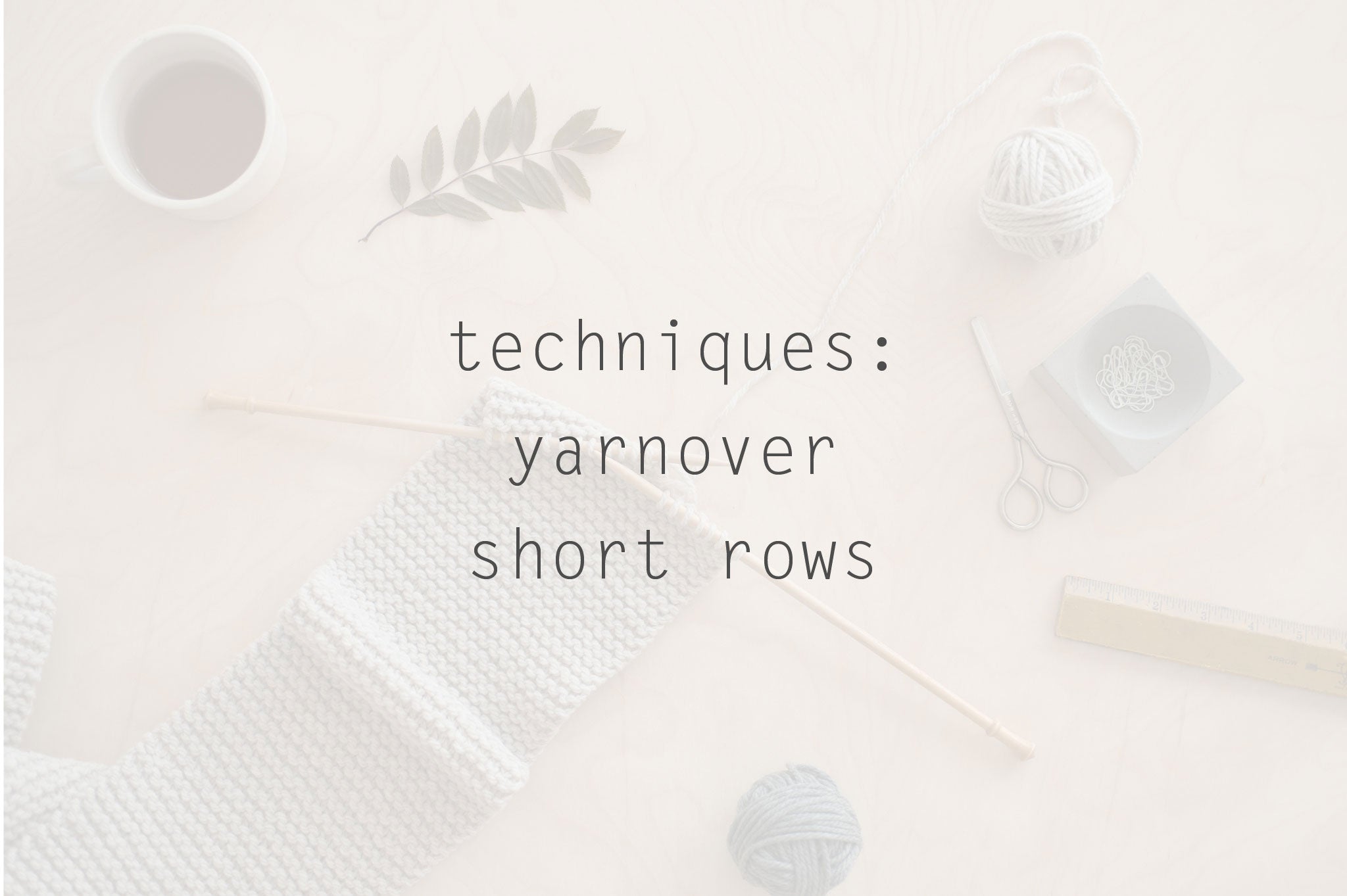techniques: yarnover short rows

yarnover short rows: what, why, and how
Short rows are knitting magic. Their name is quite literal—short rows are simply rows that aren't worked to the full width of total stitches in a complete row of knitting. At a point between the beginning and the end of a row, the knitter stops and turns to work back toward the beginning again from the wrong side. Cleverly placed and worked at specific intervals, a group of short rows creates an additional shape within the knitted fabric that doesn't interrupt the even, linear building of row upon row. No need to break yarn and work separate pieces that then have to be joined by seaming or some other overwrought method to achieve a shaped area—short rows simply return to normal knitting once shaping is complete.
Used for all manner of shaping, short rows keep the linear flow of knitting from right to left while introducing wedges of extra fabric at key areas that allow a garment to fall gracefully over the human body—some keep a flat surface, and are used for sloped shoulders, shaped hems, and back necks, and some change the direction of a piece, as for a sock heel or sleeve cap. They can even be used for clever colorwork or patterned insertions that create an interesting decorative detail in a shawl or garment.
There are many different methods of how to work a short row; minimizing the gap that forms in the fabric at each turning point in the work is where they differ. In this tutorial, we cover the yarnover short row method, which creates a near-invisible transition in the fabric between a short row section and regular rows of knitting.
how to work yarnover short rows
In stockinette stitch
On the right side, knit to the point where the short row begins. Turn work.

With the wrong side now facing, bring yarn to the back between needles and purl the next stitch so that yarn travels up and over the RH needle, creating a yarnover beside the stitch just worked. You are now ready to purl back along your short row.
On the wrong side, purl to the point where the short row begins. Turn work.

With the right side now facing, bring yarn to the front between needles and knit the next stitch so that the yarn travels up and over the RH needle, creating a yarnover beside the stitch just worked. You are now ready to knit back along your short row. Continue working short rows as specified in your pattern.
After completing your short rows, each yarnover made at a turn is decreased with the stitch that follows the gap created by the turn.


On the right side, knit to the yarnover, then k2tog the yarnover with the stitch after gap. Repeat for each yarnover as you work to the end of the row.


On the wrong side, purl to the yarnover, then ssp the yarnover with the stitch after gap. Repeat for each yarnover as you work to the end of the row.
In reverse stockinette stitch
When working in reverse stockinette, the knit rows occur on the wrong side, purl rows on the right side. To form the yarnovers after turning, hold yarn in the front if you are about to knit a stitch, and hold yarn in back if about to purl.
After completing short rows, each yarnover is decreased with the stitch that follows the gap created by each turn so that the short rows are invisible on the purl side instead of the knit.

On the wrong (knit) side, knit to the yarnover, then ssk the yarnover with the stitch after gap. Repeat for each yarnover as you work to the end of the row.

On the right (purl) side, purl to the yarnover, then p2tog the yarnover with the stitch after gap. Repeat for each yarnover as you work to the end of the row.
Working in a stitch pattern
For both right side and wrong side rows, continuing in stitch pattern when possible, work to the point where the short row begins. Turn work.
If the first stitch is a knit stitch, a brk, or a sl 1 or sl1yo that resembles the V of a knit stitch, bring yarn to the front between needles, then work the stitch, forming the yarnover beside it.
If the first stitch is a purl stitch, a brp, or a sl 1 or sl1yo that resembles the ridge of a purl stitch, bring yarn to the back between needles, then work the stitch, forming the yarnover beside it.
After completing your short rows, each yarnover is decreased with the stitch that follows the gap created by the turn. The decrease used to close the gaps will make these short rows invisible on the right side, regardless of whether they are knit stitches or purls.
On the right side, work each yarnover together with the stitch after gap, using k2tog if a knit stitch or p2tog if a purl.
On the wrong side, work each yarnover together with the stitch after gap, using ssk if a knit stitch or ssp if a purl.
Norah Gaughan's use of this technique in her book Framework: Ten Architectural Knits really piqued our interest. Among other things, the yarnover method makes short rows in patterned fabric an enjoyable, fuss-free experience. We haven't looked back. You can find this technique used in designs from Plain & Simple: 11 Knits To Wear Every Day by Pam Allen, as well as Dawn Catanzaro's Doyle shawl from the Piper 2018 collection.
Looking for other techniques covered here on the Quince blog? View all of our Techniques


















